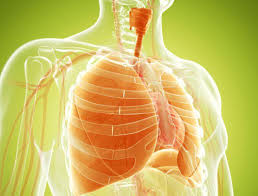Lungs Function is being discussed in this article. The function of the lungs is to make a gaseous exchange with the blood and that is because the alveoli are in contact with the capillaries. Lungs are necessary for breathing—that is, bringing oxygen into the body and getting rid of carbon dioxide. Oxygen is necessary for cells to make energy, and a by-product of the energy-producing process is carbon dioxide, which needs to be removed from the body. This critical oxygen-carbon dioxide exchange takes place in the lungs.
When we inhale air, it travels through the main breathing tube called the trachea, which divides into two tubes (main stem bronchi) in the area near the heart. One division goes to the right lung (right main stem bronchus) and the other to the left (left main stem bronchus). From there, the bronchi divide into smaller and smaller segments until they eventually become so tiny and thin that they evolve into alveoli. Alveoli are the millions of microscopic air sacs through which oxygen diffuses into red blood cells in the blood to be taken everywhere in the body. In exchange, carbon dioxide carried by the red blood cells from the body diffuses into the alveoli; it is then expelled out of the body through the airways when we exhale.
Notice that each lung is divided into sections called lobes. The right lung has three lobes, but the left lung has only two to make room for the heart. The heart assists in the vital process of breathing by pumping blood to and from the lungs.In the lungs, the blood receives the oxygen that enters the body through inhalation and at the same time releases the carbon dioxide which is eliminated by the exhalations.
Another function of the lungs is the “non-respiratory organs which can act as a filter and provide protection against external air pollution.The lungs also perform metabolic actions such as the elimination of drugs or drugs.
Two Main Lungs Function In Human Body
Respiratory function of the lungs
Non-respiratory function of the lungs
-
They act as an external filter, defending themselves from the intense air pollution to which they are exposed.
-
Metabolic actions: elimination of drugs and medications, acid-base balance, lipid metabolism by action of pulmonary surfactant, hormonal participation of the renin-angiotensin-aldosterone system.
-
System of prostaglandins, which cause bronchodilation or bronchoconstriction
What are the types of lung diseases?
- lung cancer
- Pneumonia
- Tuberculosis
- Bronchitis
- Asthma
- Emphysema
- Cystic fibrosis
- Respiratory insufficiency
- Pulmonary embolism
- Pulmonary edema
- Pulmonary hypertension
- Hardening of the lungs
- Cauterization of the lungs
